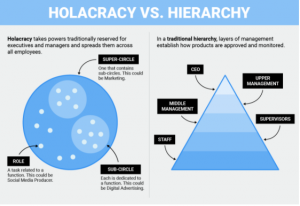Last week we talked about Holocracy, what it is and what its advocates say the potential benefits are. But in reality, does Holocracy work ? Can a type of self-management that gives decision making power to fluid teams, or “circles,” and roles rather than individuals yield results and better decisions than a traditional structure? How well do people deal with the uncertainty that a holocratic approach creates?
Sourcing and Hiring
Holocracy models complicate sourcing and hiring decisions. How do you advertise for a job that is comprised of ever changing micro roles and how do you assess whether the person sitting in front of you actually is competent at those micro roles and any other talents they might have? People are used to looking for traditional job titles, but in holocracy, there are no traditional job titles. Do management level employees worry that deviating from their career path might stall out their careers. What if they are at a Director level now and you are trying to recruit for a team member with a skill set normally held by an Accounting Dir. How many would take a “team or circle member” title?
Micro Roles
Another issue that holocracy creates is the formation of micro roles. No longer is one individual responsible for a specific set of set roles, but a swirling set of micro roles that are ever changing. It can complicate the work actually getting done as employees may be responsible for up to 25 different responsibilities and struggle with prioritizing them and deciding where to focus first. They may be members of a number of different circles and have weighty responsibilities to each, but not be able to satisfy all of them or be forced to prioritize in conflict with others.
Compensation
Compensation becomes difficult as well. Not only are there struggles with determining internal equity as this now requires each of 100’s of micro roles to be assessed and the value of these roles change as new circles are created and as the organization matures and different skills become more or less valuable, but external equity is an issue. How do you go to the market to assess the worth of a position when there is no longer a match for the position? There is nothing to compare the person’s position to.
Unlearning old behavior
For holocrcay to be successful it necessitates that both bosses and subordinates unlearn old behavior. If everyone is truly to be tapped for their full potential then there cannot be those who are hesitant to express opposing views in front of what used to be superiors. This is a hard habit to break for both bosses and subordinates. It is hard for leaders to learn to step back and not lead all the time.
Holocary has yet to be proven as a model that offers significant benefits over a traditional structure. The best of both worlds may be to incorporate some of the circle mentality into the traditional structure allowing everyone a voice to be heard and encouraging growth horizontally as well as vertically.


